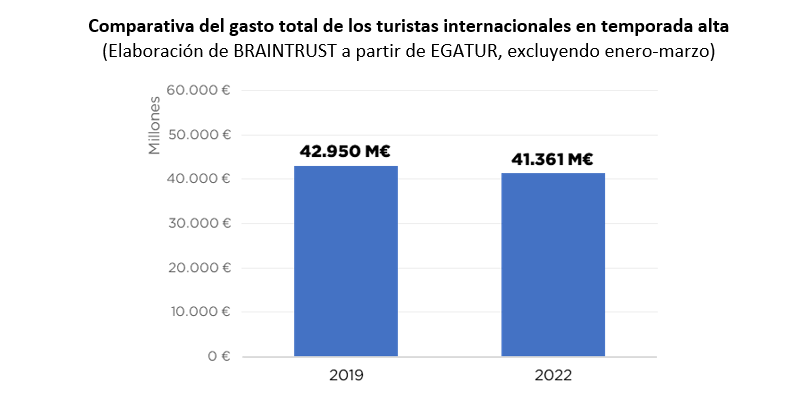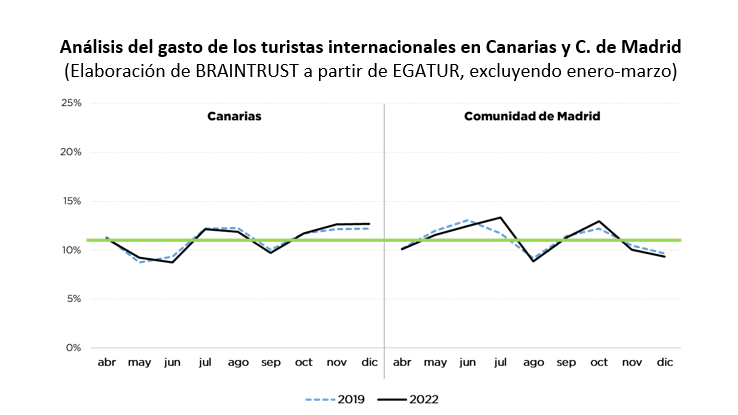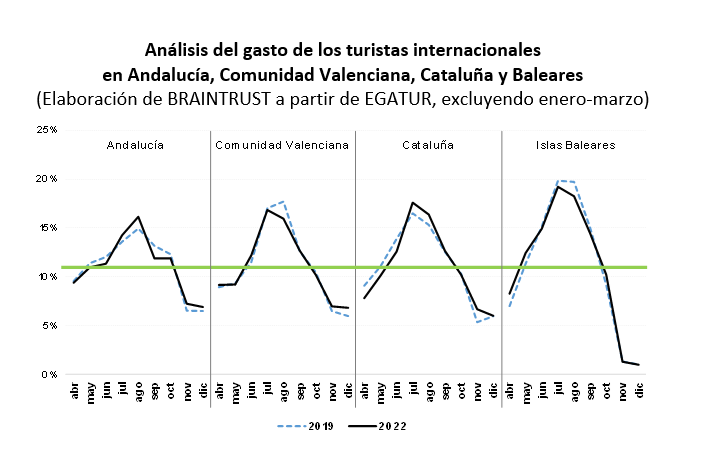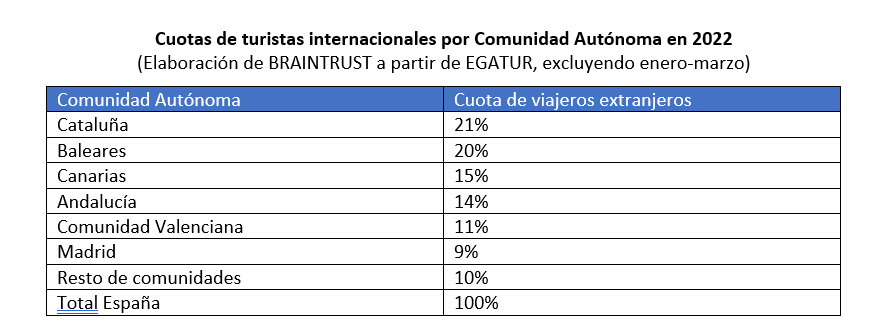The consulting and professional services firm BRAINTRUST, a leader in the tourism sector, has issued a new industry report, in this case on the seasonality of foreign tourist spending, thanks to a new wave of its Tourism Barometer, for whose comparative analysis it has excluded the first 3 months of 2022, which were atypical due to the Omicron wave.
This analysis shows that Spain as a country urgently needs a deseasonalization plan, since the four months of high season, from June to September, account for almost 60% of total foreign spending in Spain.
Only the Canary Islands and Madrid have a more stable influx of foreign tourism throughout all months of the year, according to data provided by the consulting firm.
BRAINTRUST states that in some cases, such as Catalonia or the Balearic Islands, spending is even more seasonal, reaching 67% in the Balearic archipelago, which leads to a very precarious model in terms of economic sustainability and, above all, employment, an aspect that is becoming increasingly important in an era of talent shortage in the tourism industry.
Even with lower tourist numbers in 2022, the seasonality analysis is similar to 2019, showing that the pandemic has not yet improved the model
In the search for an objective comparison. BRAINTRUST excludes the first 3 months for the comparative analysis between 2022 and 2019, due to the omicron wave last year that kept foreign tourism movements to our market at bay.
In that context he points out that last year a total of 61,886,065 foreign tourists arrived in Spain from April to December, which compared to the 69,283,430 in 2019, represented an 89% increase compared to pre-pandemic times, confirming an unprecedented recovery in the last 9 months of the year.
If we talk about spending, the consultancy states that from April to December the total foreign tourist spending in 2022 was 75,208,598,893 euros, which compared to the 91,911,973,022 euros in 2019, was 81% compared to pre-pandemic times.
Comparing both years, we can observe according to the consultant that seasonality has practically not moved, being the expenditure of the 4 months of high season from June to September a percentage of 55% in 2022, compared to 2019 which accounted for 56%, demonstrating that the pandemic has not served to improve the model yet, suffering from a pronounced seasonality, which may jeopardize the sustainability of the economic model and employment if not remedied quickly and consistently.

Canary Islands and Madrid enjoy a stable flow of travelers throughout the year
Two communities enjoy a stable seasonal pattern, such as the Canary Islands and Madrid, which for different reasons experience a continuous influx throughout all the months of the year. The Canary Islands for its climate and gastronomy, and Madrid for its cultural and leisure attractions, are knowing how to channel their offer at different times of the year, promoting an example of tourism that ensures the economic model, and promotes solid and quality employment, reverting its benefits fully to the local society that sees with good eyes the arrival of the international tourist that leaves in its coffers a money that is reinvested in the destinations.
Andalusia, the Valencian Community, Catalonia and the Balearic Islands suffer from high seasonality
The rest of the communities that complete the sextet of destinations preferred by foreigners, however, suffer from a marked seasonality, concentrating in 4 months a good part of the tourists. These are regions in which seasonal adjustment plans must be conscientiously defined and developed if a more sustainable model of tourism is to be pursued, and if the potential rejection that tourists provoke in the local population is to be avoided, who look askance at how places become overcrowded in the high season, while in the low season they are closed down, leaving behind a more precarious economic model and lower quality and discontinuous employment.
For José Manuel Brell, Partner in charge of the Quantitative Studies and Models practice, and of the Tourism and Leisure Industry at BRAINTRUST: "The abrupt recovery of foreign tourism once again shows that the model continues to be precarious, and that the pandemic has not served to establish different policies, therefore, we continue to suffer from a very pronounced seasonality that endangers the sustainability of the largest industry in our country. Those responsible for tourism organizations at the national, regional and local levels should take note of this. We cannot waste this moment to transform our model in order to continue being world leaders in a different kind of tourism than the one we have seen to date, which is very much based on "sun and beach".
6 communities account for 93% of foreign tourist spending, showing a lack of diversification that should be resolved with the PSTD.
On the other hand, BRAINTRUST once again reveals a scarcely diversified model, by specifying foreign tourism spending in 2022, once again excluding the 3 months of January to March. Thus, in 2022, Catalonia would take 20% of the share of spending by foreign travelers, followed by the Balearic Islands with 19%, the Canary Islands with 18%, Andalusia with 14%, and finally the Valencian Community with 12% and the Community of Madrid with 11%, adding together these 6 C.C.A.A. 93% of total foreign spending, leaving the rest of the Spanish communities with a meager 7% of the total. The Tourism Sustainability Plans in Destination or PSTD have distributed a large part of their budget to communities, regions and localities outside the usual circuit of foreign tourism, so these PSTD should serve to decentralize the flow of international travelers from the most overcrowded areas to poles of attraction in other areas of interest, helping to transform the tourism model in our country.
The same 6 communities account for 90% of the number of foreign travelers
In the case of travelers, the data speak similarly, as these same 6 communities account for 90% of international travelers, with the following breakdown:

For Angel García ButragueñoCo-Director of the Tourism Barometer, and Director of Tourism at BRAINTRUST: "We have an even greater challenge ahead of us compared to pre-pandemic times. While the Next Generation funds were devised to transform the tourism model in our country, and the tourism sustainability plans at destination have gone to many places in Spain, the international influx continues to choose the same areas, demonstrating little diversification, with the danger that such PSTD only serve to spruce up the places. And the fact is that without different communication and promotion strategies, whose concrete plans have not been included in most of PSTD, the tourist coming to Spain will not be aware of our tourist capital, affecting the overcrowding of some already mature destinations, promoting an outdated system from which we must leave urgently if we want to be an international reference of tourism in the world. We must take the opportunity to innovate and renew the tourism vision in the coming years, avoiding falling into the usual short-termism of politics and laying the foundations of a future thought, planned and executed with a sense of state, and business perspective, where all regions of Spain with a unique and unbeatable tourism capital will benefit from the tourism sector, helping to mitigate the effects of depopulation and aging.."






